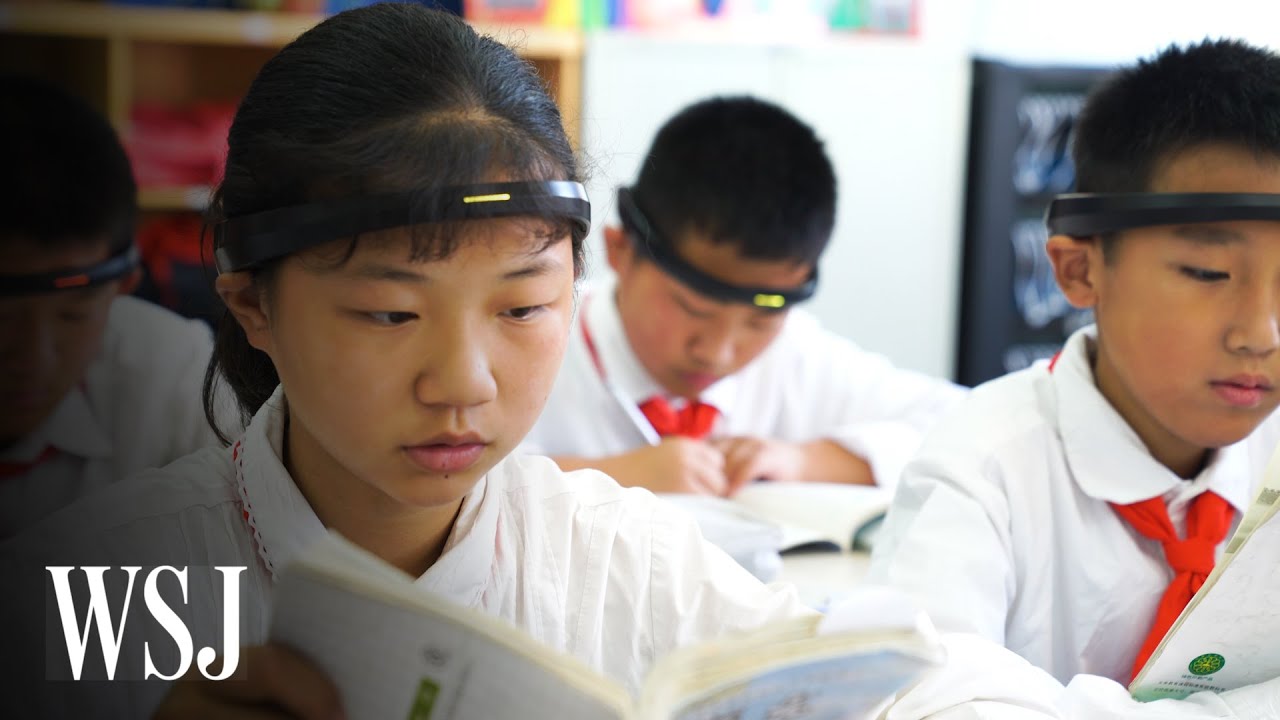In China, classrooms are adopting artificial-intelligence cameras and brain-wave trackers to enhance learning. While some view these technologies as beneficial for improving grades, they have become a source of unease for many children. The implementation of these devices marks China’s ambition to become a leader in artificial intelligence, evident in its advancements such as a cashless economy and extensive surveillance networks. These AI tools in classrooms include robots that analyze student health and engagement, uniforms with tracking chips, and surveillance cameras that monitor phone usage and even yawning. While these initiatives have raised concerns among Chinese netizens, schools argue that obtaining parental consent to participate in this massive AI experiment has not been difficult, as it holds the promise of boosting students’ grades through powerful algorithms. Despite the detailed reports generated by these devices, questions remain about their effectiveness and what exactly they measure. As the government invests billions in this project, it brings together tech giants, start-ups, and schools. With exclusive access to a primary school outside Shanghai, we observe the implementation of AI technology firsthand. Students start their day by putting on brain wave sensing gadgets and engaging in meditation exercises. The devices, equipped with electrodes, measure electrical signals sent by neurons in the brain, providing real-time data on students’ attention levels. Teachers receive a detailed report on the class’s attention span, including each student’s concentration level at ten-minute intervals, which is then shared with parents via a chat group. Though the effectiveness and precise measurement capabilities of these devices are unclear, teachers claim that they have encouraged discipline and improved student attention. This has resulted in better academic performance and higher grades for some students. However, not all students are enthusiastic about this technology. One fifth grader mentions being punished by their parents for low attention scores, highlighting the added pressure that such data can create for students. Companies state that the data collected may be used in government-funded research projects, but the destination remains unclear. Privacy concerns are another issue, with little to no protection for this personal data. As China embraces artificial intelligence, experts and citizens raise alarms about the potential consequences of this nationwide push. These AI-filled classrooms serve as laboratories for future generations, and the full impact of these technologies won’t be apparent until today’s students become adult citizens.

Introduction
In recent years, China has been making significant strides in the field of artificial intelligence (AI), particularly in the education sector. The country has implemented various AI technologies in classrooms, aiming to improve students’ performance and create a more advanced learning environment. While many parents and teachers see these technologies as valuable tools to enhance education, they have also raised concerns about privacy, data usage, and the long-term effects on students. This article will explore China’s plans to become a global leader in AI, the specific technologies being used in Chinese classrooms, the effectiveness and concerns surrounding these technologies, and the role of government funding and collaborations. We will also examine expert opinions on AI in education and discuss the concerns and future implications of this growing trend.
China’s Plans to Become a Global Leader in AI
China has set its sights on becoming a global leader in AI, and it has already made significant progress in various domains. One area where AI has been widely implemented is the cashless economy, where facial recognition technology allows people to make purchases using their faces. This technology has revolutionized the way transactions are conducted in China, providing convenient and seamless payment options for individuals.
Another prominent use of AI in China is the vast network of surveillance cameras equipped with facial recognition technology. These cameras enable the government to effectively monitor citizens and maintain public safety. While the technology has proven useful in identifying and tracking individuals, it has also raised concerns about privacy and potential misuse of personal information.
Furthermore, Chinese schools have incorporated high-tech education strategies into their classrooms, providing a glimpse into the future of education. These strategies include the use of AI cameras and brain-wave trackers to analyze students’ health and engagement levels. Students also wear uniforms with chips that track their locations, and surveillance cameras monitor their phone usage and attention levels during class. While these technologies aim to improve education outcomes, they have sparked alarms among Chinese netizens.
AI Technologies in Chinese Classrooms
Chinese classrooms have embraced AI technologies, employing various tools to enhance students’ learning experiences. One such tool is the use of brain-wave trackers, which measure students’ concentration levels. These trackers consist of headbands with electrodes that pick up electrical signals sent by neurons in the brain. The collected neural data is then sent in real-time to the teacher’s computer, allowing them to assess students’ attention levels during class.
Another AI technology used in Chinese classrooms is meditation and concentration exercises. Students are encouraged to practice meditation, enhancing their ability to focus and concentrate on tasks. This approach aims to improve students’ attention spans and overall engagement in the learning process.
Real-time monitoring is another significant aspect of AI technologies in Chinese classrooms. Teachers can quickly determine which students are paying attention and which ones need additional support. They can generate reports detailing individual students’ concentration levels at regular intervals and share this information with parents through chat groups.
Additionally, parental involvement is encouraged through the use of AI technologies in Chinese classrooms. Parents can stay informed about their child’s performance, concentration, and overall engagement through the reports generated by the AI tools. This allows parents to play an active role in supporting their child’s education.
Effectiveness and Concerns
While AI technologies in Chinese classrooms offer promising benefits, there are concerns about their effectiveness and potential negative impacts on students. One major concern is the uncertainty about the accuracy of measurement. Some experts question whether the devices used to measure concentration levels truly work as intended. Electroencephalography (EEG), the technology used to analyze brain-wave data, is known to be susceptible to artifacts, meaning external factors can affect the accuracy of the readings.
Despite these concerns, teachers have reported that AI tools, such as brain-wave trackers and real-time monitoring, have had positive effects on student discipline and attention. Students who use these tools reportedly pay better attention in class, study harder, and achieve higher scores. However, not all students are enthusiastic about these technologies.
The pressure to perform and the disciplinary measures associated with low attention scores have added new burdens for some students. Punishments from parents based on the data generated by AI technologies can create additional stress and anxiety for students. It is crucial to consider the potential psychological impacts of these technologies on students’ overall well-being.
Furthermore, there are concerns about the usage and privacy of the data collected by AI technologies in Chinese classrooms. While some companies state that the data can be used for government-funded research projects, there is uncertainty about where exactly the data ends up and the level of privacy protection provided. Privacy experts argue that student assessments should not be reduced to solely data points, and the potential misuse of personal data is a significant concern.

Government Funding and Collaborations
The Chinese government has invested billions of dollars into AI education projects, bringing together tech giants, start-ups, and schools. This collaboration aims to create a robust AI education system that can enhance students’ academic performance while also providing valuable data for AI algorithm development.
This government funding has allowed schools to implement AI technologies more readily and enroll students in what is now one of the largest AI education experiments in the world. The combination of financial resources and technological advancements has facilitated the widespread adoption of AI technologies in Chinese classrooms.
Expert Opinions on AI in Education
Experts have voiced their concerns about the increasing use of AI in Chinese classrooms. Theodore Zanto, a neural scientist at the University of California San Francisco, expressed surprise at the use of electroencephalography (EEG) on children in the classroom. EEG, a technology commonly used by doctors in hospitals and labs, has limitations and can produce false readings due to artifacts or improper setup.
Zanto emphasizes that EEG measurements are subject to various external factors, such as itching or fidgeting, which can distort the accuracy of the signals. Despite these limitations, teachers have observed that the headbands and other AI tools have led to improved discipline and attention among students.

Concerns and Future Implications
While the implementation of AI technologies in Chinese classrooms has the potential to benefit millions of students, concerns have been raised about various aspects of this AI-driven educational approach. Experts and citizens alike have sounded alarms about privacy, data usage, and the long-term effects on students.
These classrooms serve as laboratories for future generations, and the impact of these new tools may not be fully apparent until students transition into adulthood. The long-term effects of surveillance, data collection, and the pressure to conform to AI-driven metrics are topics that warrant further exploration and consideration.
Additionally, the reliance on AI technologies in Chinese education raises questions about the impact on creativity, critical thinking, and individuality among students. As the education system becomes increasingly driven by AI algorithms and measurements, there is a need to balance technological advancements with the holistic development of students.
Conclusion
China’s pursuit of becoming a global leader in AI has led to the widespread implementation of AI technologies in classrooms. While these technologies offer potential benefits such as improved discipline, attention, and academic performance, there are concerns surrounding their accuracy, data privacy, and long-term effects on students.
The Chinese government’s investment in AI education and collaborations with tech giants, start-ups, and schools have accelerated the adoption of AI technologies in Chinese classrooms. However, it is crucial to address the concerns raised by experts and citizens about privacy, the potential pressure on students, and the impact on their overall well-being.
As technology continues to advance and shape the future of education, it is essential to strike a balance between leveraging the benefits of AI and ensuring the holistic development of students. The use of AI in education should be guided by ethical considerations, privacy protection, and a comprehensive understanding of the potential long-term effects on students as they progress into adulthood.







Leave a Reply